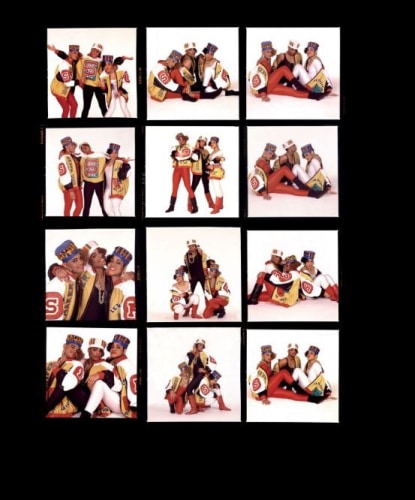
Hip-hop music was initially derided as a fad, a passing novelty somehow artistically unequal to rock or pop. Today, hip-hop is pop music and a driving force of pop culture. Rappers headline music festivals and receive extensive coverage from national news outlets. Rap songs perennially top music sales charts. Contemporary fashion, slang, art — hip-hop influences all of it.
In recent years, hip-hop’s continued popularity has inspired countless documentaries, biographical films and books concerning the genre’s pivotal music and artists. These endeavors are vital for preserving and contextualizing hip-hop history. However, they often neglect the people whose work significantly contributed to hip-hop’s rise: photographers.
Vikki Tobak’s “Contact High: A Visual History of Hip-Hop” attempts to rectify this oversight. An expansive photography book that covers nearly 40 years of hip-hop history, it features now-iconic images of globally renowned artists like Tupac, Notorious B.I.G. and Outkast alongside interviews with the photographers and essays from their subjects. After the book’s 2018 release, Tobak and hip-hop pioneer Fab 5 Freddy (“Yo! MTV Raps”) turned “Contact High” into a photography exhibit.
Showing at Century City’s Annenberg Space for Photography through Aug. 25, “Contact High” is essential viewing. With almost 140 works from 60 photographers and more than 75 original, unedited contact sheets, it’s likely one of the most comprehensive hip-hop photo galleries ever assembled. For lifelong hip-hop disciples and laypeople alike, the exhibit illuminates the reality that music is enhanced by and inextricable from the visuals that accompany it.
Most of the names beneath the photos at the Annenberg will likely be unfamiliar at first. By the end of the exhibit, though, their photos will make them unforgettable. The stare of MF Doom piercing your soul from behind his signature metal gladiator mask? Eric Coleman captured it. Salt-N-Pepa projecting their strength and swagger in vibrant, multi-colored and coordinated outfits? Janette Beckman was behind the lens. Notorious B.I.G. wearing the crown that signified his status as rap’s “king of New York” in 1997? Barron Clairborne shot that.
The front half of the exhibit is arranged chronologically. First, viewers encounter early DJs, rappers and breakdancers from New York, the undisputed birthplace of hip-hop. Many of these, like black-and-white photos of DJ Kool Herc and Tony Tone, come from Bronx photographer Joe Conzo.
Conzo and his “Contact High” peers working through the ’90s documented hip-hop during the era of its heaviest criticism and greatest neglect from critics outside of the disenfranchised communities making the music. Implicitly, the exhibit argues that photographers should be intimately connected to their subjects and communities. The exhibit’s featured photographers are ardent fans of the music who had real relationships with their subjects. They worked for rap magazines like Rap Pages and XXL — some of which are on display — publications that covered every plateau and niche of the genre with informed and nuanced appreciation. Where small-minded (and likely bigoted) detractors saw hip-hop as dangerous music made by dangerous people, these photographers documented the humanity of the genre’s musicians, major figures and subcultures.
The photographers’ respect and affection for their subjects are perhaps most apparent in the section of the exhibit devoted to the women of hip-hop. In Janette Beckman’s contact sheet from her 1988 photo “Ladies of Hip-Hop,” for instance, she captures the comradery among Millie Jackson, Roxanne Shante, MC Lyte and the women rappers and dancers of the late ’80s.
The same is true as the parallel New York section moves into the ’90s. On the contact sheet for Clairborne’s Notorious B.I.G. shoot, there are a few shots of him smiling. The images stand in stark contrast to the bravado of his lyrical delivery and the often grim subject matter of his lyrics, which “Contact High” visitors can hear in the looped video of his infamous streetcorner freestyle in Brooklyn. Like many of the contact sheet photos, these feel like a privileged glimpse behind the necessary but ultimately constructed artistic persona.
Much of the rest of the exhibit explores hip-hop’s regionality. Here, walls of Los Angeles rappers like Dr. Dre, Kendrick Lamar and the late Nipsey Hussle are framed opposite photos of rappers from Atlanta (e.g., Gucci Mane) and New Orleans (e.g., Lil Wayne). Throughout, viewers will notice the various indigenous clothing styles. In the workwear worn by L.A. rappers and the Nike Air Force Ones sported by rappers from other locales, you can see hip-hop’s influence on contemporary fashion trends discussed in GQ and appropriated on runways.
“Contact High” also features a 30-minute documentary created for the exhibit. For the uninitiated, this documentary brilliantly contextualizes the history of hip-hop and hip-hop photography. With insightful, often humorous interviews from “Contact High” photographers like Brian “B+” Cross, it explains the importance of the connection (cultural, social, racial, etc.) between photographer and subject. Once you’ve finished watching the documentary, you can sort through records in the adjacent record store/gift shop curated by Cross.
While the exhibit is excellent for the reasons stated above, it will likely feel too small for hip-hop obsessives. There are no photos from Chi Modu, the former director of photography for seminal hip-hop magazine The Source; independent and underground artists from all over the U.S. are also underrepresented. These shortcomings only expose the need for more exhibits like “Contact High.” Capturing every significant style, era and subset of hip-hop would require a multistory museum. Soon enough, maybe there will be one.
“Contact High: A Visual History of Hip-Hop” remains on display through Aug. 25 at Annenberg Space for Photography, 2000 Avenue of the Stars, Century City. The gallery is open from 11 a.m. to 6 p.m. Wednesdays through Sundays. Admission is free. Visit annenbergphotospace.org for venue information.